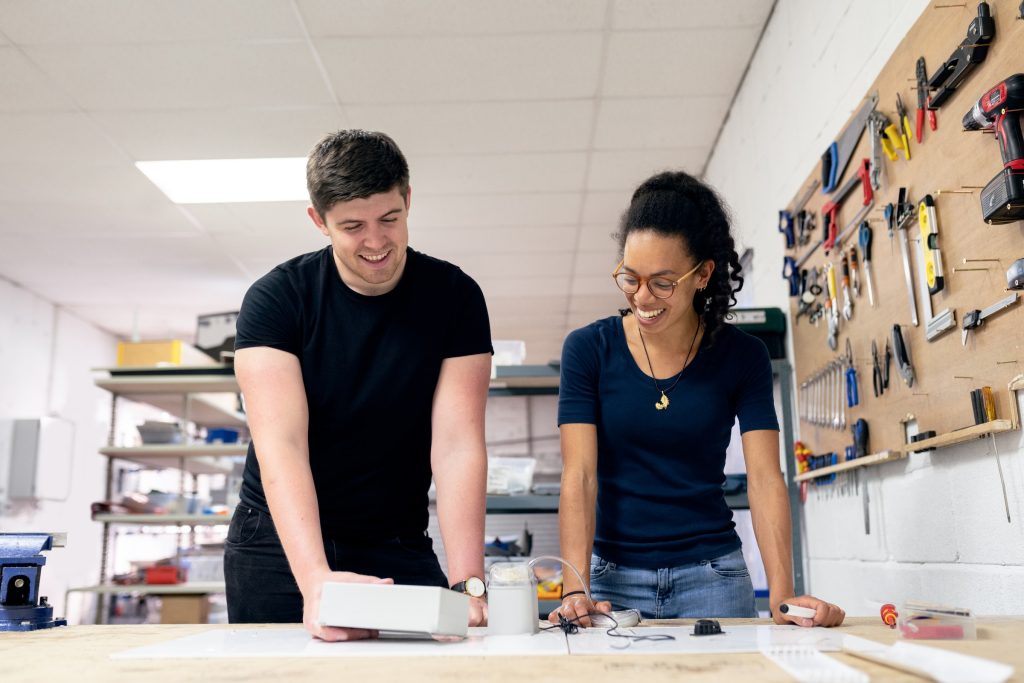Panel interviews are a vital component of the recruitment process, offering a comprehensive evaluation by incorporating diverse perspectives. However, to maximize their effectiveness, it’s crucial to have a well-structured approach.
To revolutionize the way your organization conducts panel interviews, start by emphasizing diverse expertise in the panel. Instead of clustering members from similar departments, include individuals who bring varied perspectives and skills to the table. This not only enriches the discussion but also ensures a holistic evaluation of candidates, examining them from multiple angles — cultural fit, technical prowess, and strategic thinking.
Furthermore, foster collaboration well before the interview date. Organize pre-interview meetings where panelists can discuss interview goals and assign specific questioning roles based on their strengths. By doing so, you create a structured yet fluid environment where each panelist knows their contribution’s impact ahead of time. The result? A more cohesive interview process that reduces redundancy in questioning and keeps candidates engaged with dynamic dialogue throughout.
This blog delves into the steps and strategies for collaborating effectively to build a better panel interview structure, ensuring a seamless and efficient recruitment process.
Understanding the Benefits of Panel Interviews
Before discussing the strategies for building an effective panel interview structure, it’s essential to understand the benefits they offer:
- Diverse Perspectives: Multiple interviewers bring varied viewpoints, providing a holistic assessment of the candidate.
- Reduced Bias: The presence of several interviewers helps mitigate individual biases, leading to a more objective evaluation.
- Efficiency: Panel interviews consolidate multiple interview rounds, saving time and resources.
- Comprehensive Evaluation: Different panel members can focus on various aspects of the candidate’s qualifications, ensuring a thorough assessment.
Steps to Building an Effective Panel Interview Structure
- Define Clear Objectives and Roles
The first step in building an effective panel interview structure is defining clear objectives. Identify the key competencies, skills, and attributes required for the role. Once the objectives are clear, assign specific roles to each panel member based on their expertise.
Action Points:
– Identify the core competencies and skills necessary for the role.
– Assign each panel member specific areas to assess, such as technical skills, cultural fit, or problem-solving abilities.
– Ensure each panel member understands their role and the interview objectives.
- Select the Right Panel Members
Choosing the right panel members is crucial. The panel should consist of individuals who interact with the role in different capacities. This could include the hiring manager, a potential team member, a representative from HR, and someone from another department.
Action Points:
– Select panel members with diverse backgrounds and perspectives relevant to the role.
– Ensure panel members have a thorough understanding of the role and its requirements.
– Include individuals who can provide objective evaluations.
- Develop a Structured Interview Format
A structured interview format ensures that all panel members are aligned and that the interview covers all necessary areas. Develop a set of standardized questions that align with the competencies and attributes you are assessing. This helps maintain consistency and fairness.
Action Points:
– Create a standardized set of questions for each key competency.
– Include a mix of behavioral, situational, and technical questions.
– Develop a scoring rubric to assess candidate responses consistently.
- Conduct Pre-Interview Briefings
Pre-interview briefings are essential to align all panel members on the interview process, objectives, and individual roles. This meeting allows panel members to discuss the candidate’s resume, the job description, and specific areas of focus.
Action Points:
– Schedule a pre-interview briefing with all panel members.
– Review the candidate’s resume and background.
– Discuss the job description and key competencies to assess.
– Clarify each panel member’s role and the flow of the interview.
- Foster a Collaborative Interview Environment
During the interview, fostering a collaborative environment is crucial. Ensure that each panel member has an opportunity to ask their questions, take notes, and discuss their observations. Collaboration ensures a comprehensive and balanced evaluation.
Action Points:
– Ensure each panel member has a chance to ask their questions.
– Encourage active listening and note-taking.
– Avoid interrupting or overshadowing other panel members.
- Post-Interview Debrief and Evaluation
After the interview, conduct a debriefing session with all panel members to discuss the candidate’s performance. This collaborative evaluation helps ensure that all perspectives are considered, leading to a well-informed decision.
Action Points:
– Schedule a post-interview debriefing session.
– Discuss each panel member’s observations and assessments.
– Use the scoring rubric to evaluate the candidate’s responses.
– Reach a consensus on the candidate’s suitability for the role.
Tips for Effective Panel Interviews
- Preparation is Key:
Ensure all panel members are well-prepared by reviewing the candidate’s resume and understanding the job requirements. Preparation helps in asking relevant questions and making informed evaluations.
- Consistency:
Maintain consistency by using standardized questions and a scoring rubric. This ensures that all candidates are evaluated on the same criteria, making the process fair and objective.
- Communication:
Effective communication among panel members is crucial. Encourage open discussion and sharing of observations during the debriefing session to ensure a holistic evaluation of the candidate.
- Respect the Candidate:
Respect the candidate’s time and effort by conducting a well-organized and professional interview. Ensure that each panel member is respectful and considerate in their questioning and interactions.
- Feedback:
Provide constructive feedback to candidates after the interview. This not only helps candidates improve but also enhances your organization’s reputation as a fair and transparent employer.
Common Challenges and How to Overcome Them
- Dominance of One Panel Member:
If one panel member dominates the interview, it can skew the evaluation. To overcome this, ensure that each panel member has a designated time to ask their questions and that there is a moderator to manage the flow of the interview.
- Inconsistent Evaluation:
Inconsistent evaluation can occur if panel members use different criteria to assess candidates. Using a standardized scoring rubric and conducting pre-interview briefings can help maintain consistency.
- Panel Disagreements:
Disagreements among panel members can arise during the evaluation. Encourage open and respectful discussion during the debriefing session and aim to reach a consensus based on the scoring rubric and objective criteria.
Conclusion
Building a better panel interview structure requires careful planning, collaboration, and communication. By defining clear objectives, selecting the right panel members, developing a structured interview format, and fostering a collaborative environment, organizations can enhance the effectiveness of their panel interviews. This structured approach not only ensures a fair and comprehensive evaluation of candidates but also contributes to better hiring decisions and a more efficient recruitment process. By continuously refining and improving the panel interview structure, organizations can attract and hire the best talent, ultimately driving their success and growth.
- Pre-Interview Preparation:
The panel members conduct a pre-interview briefing where they discuss the job requirements, the candidate’s resume, and assign specific areas for each member to focus on.
- Structured Interview:
During the interview, each panel member asks standardized questions related to their assigned area. The senior developer focuses on technical skills, the HR representative assesses cultural fit, the product manager evaluates problem-solving abilities, and the hiring manager oversees the overall flow.
- Post-Interview Debrief:
After the interview, the panel members meet to discuss their observations and use a scoring rubric to evaluate the candidate. They consider all perspectives and reach a consensus on the candidate’s suitability.
Outcome:
The structured and collaborative approach leads to a well-rounded evaluation of the candidate, resulting in a successful hire who fits well with the team and performs effectively in the role.
By following these steps and continuously refining the process, organizations can build a better panel interview structure that enhances the quality of their hires and contributes to their long-term success.
In conclusion, creating a more effective panel interview structure requires thoughtful collaboration and strategic planning. By aligning the goals and expectations among all interviewers, you ensure a cohesive assessment of each candidate. Utilizing clear roles and consistent criteria can mitigate biases and enhance the evaluation process. Encouraging open communication and feedback further refines the approach, making your panel interviews more robust over time. To optimize your hiring process, start implementing these collaborative strategies today and watch your team grow stronger with every new addition.
Interviewer.AI is a technology platform purposely built to support Recruiters and HR teams in finding top talent for their companies. We also work with universities to help them with admissions and coaching, helping them use technology to solve for talent and training. Our mission is to make hiring equitable, explainable, and efficient. to screen in advance and shortlist the candidates that meet the criteria set.
Learn more about how Interviewer.AI can help your business. Schedule a demo today!
Srividya Gopani is the Co-founder, Chief Marketing and Product Officer at Interviewer.AI. She enjoys working on technology which is central to this role as the driver for marketing and product for Interviewer.AI.







